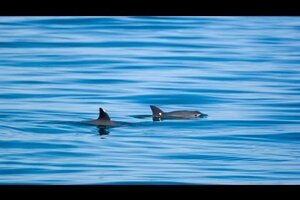How Mexico plans to save the last few vaquita porpoises
There may be as few as three dozen vaquita porpoises left in the world. Mexico hopes an international effort to catch and enclose the porpoises will protect them, though some are skeptical.

The vaquita porpoise, which lives exclusively in the Upper Gulf of California, Mexico, is in danger of extinction. Mexico is planning a catch-and-enclose effort in the spring with the hope of protecting the vaquita.
Experts from around the world are coming together in a concerted effort to protect the world’s most endangered whale species from extinction – though not everyone is on board.
Vaquita porpoises live exclusively in the upper Gulf of California, also known as the Sea of Cortez. Only discovered by scientists in the 1950s, there may now be as few as three dozen left, including just eight breeding females. To save them, the International Committee for the Recovery of the Vaquita is putting together an international team that will capture the few remaining vaquita porpoises and enclose them in an area of the Gulf of California where they would be safe from fishing nets.
Until now, Mexico had been working to protect the porpoises in their natural habitat – and some say that’s still the best approach. Advocates of the catch-and-enclose effort note that it comes with risks, but believe it’s still worth trying.
“Locating them, capturing them, there is an inherent risk to everything,” Lorenzo Rojas-Bracho, the chairman of the recovery committee, told the Associated Press reported. But, he said, “We have to do something, as an emergency measure.”
Certain species have been successfully preserved in captivity, including the red wolf and the California condor. But it’s unclear whether the vaquita, which has always roamed free, would respond similarly. Some say the risks of capture alone are too high: If the females died during capture, that would be the end for the vaquita.
Previous efforts to protect the vaquita focused on fishing restrictions. Gillnets, which are illegal in some areas, were banned, and fishermen in the upper gulf were compensated for reduced income. The Mexican navy also patrols the area to prevent illegal activity.
Breaking these laws can bring a hefty payoff, however. The totoaba, a fish that swims in the same water, is a delicacy in China and elsewhere. Its bladder can sell for $5,000 in the United States, and fetches twice that in Asia.
Illegal fishing may be one reason why the vaquita porpoise population has dropped by more than half over the past 3 years, according to the World Wildlife Fund. But laws to protect the vaquita have limited fishing activity in the area. If the porpoises were moved elsewhere, fishermen would likely swoop in and overfish the waters, jeopardizing other species, like the totoaba.
The WWF’s Mexico director, Omar Vidal, says enclosure isn’t the answer if Mexico wants to protect the entire Gulf of California ecosystem.
“We must strive to save this porpoise where it belongs: in a healthy Upper Gulf of California,” he said, according to AP.
With that in mind, Mr. Vidal and others have been working to clean up the area, getting rid of hidden nets. That’s the best way to help the porpoises, they believe.
But to Mr. Rojas-Bracho of the vaquita recovery committee, the vaquita’s future depends on a successful capture effort. To make it happen, the committee is calling on skilled veterinarians, acoustic monitoring specialists, and porpoise capture experts from around the world.
"The team is the best that can be put together in the world. It is the 'dream team,' " he said
A research team with Mexico’s environment department has located two appropriate sites for the vaquita enclosure, and the capture effort is expected to begin in the spring.
This report contains material from the Associated Press.

